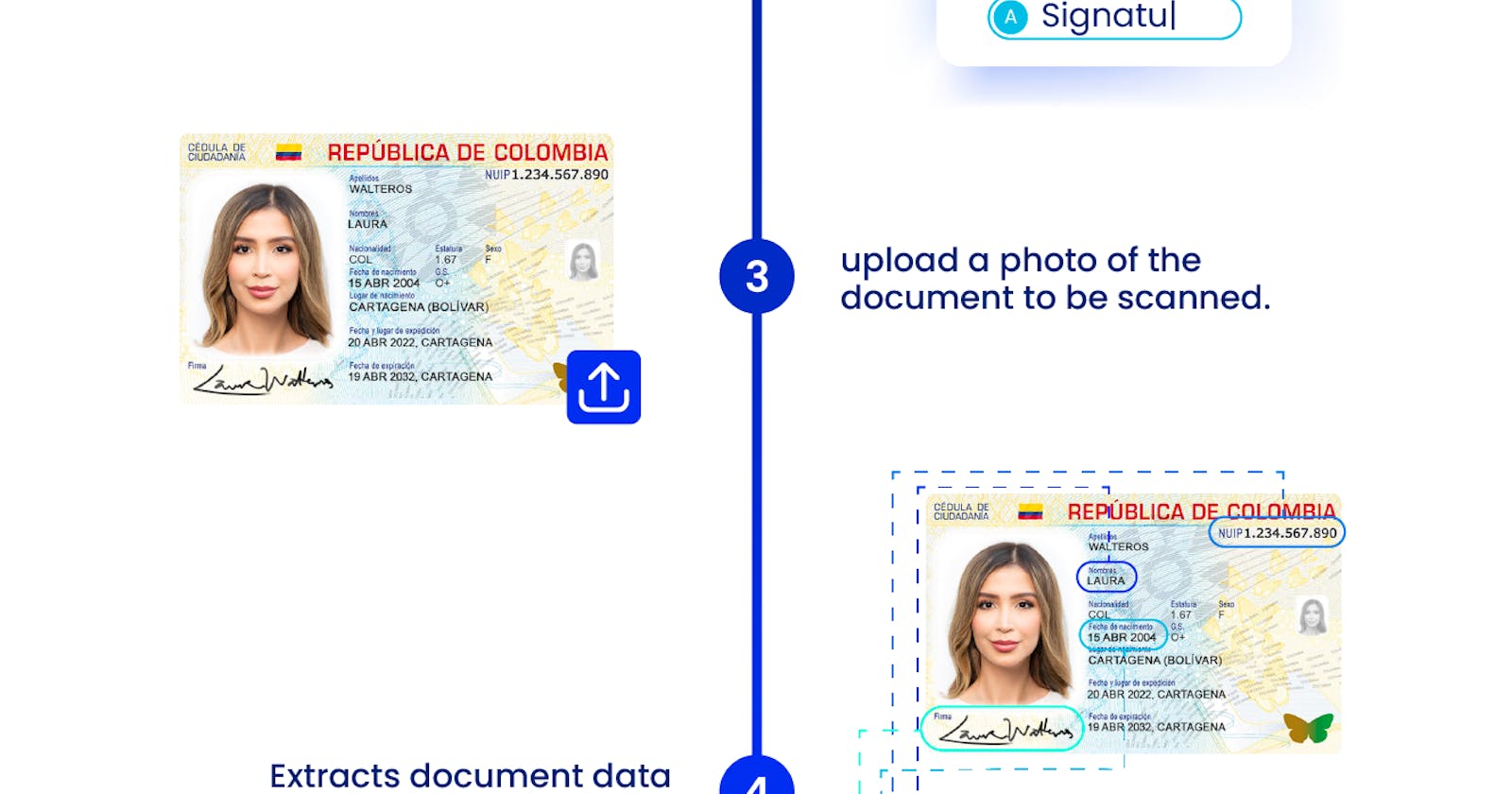In our quest for exceptional tech solutions, we’ve recently come across an absolute game-changer in the world of Optical Character Recognition (OCR). Called Verifik, this service offers a potent OCR API that has made a significant impact on how we handle document processing tasks. In this article, we will explore the service, how it works, and why it stands out from the crowd.
Introduction to Verifik’s OCR API
Verifik has designed an OCR API that allows businesses and developers to efficiently process digital images and extract valuable information from them. Whether it’s a scanned document, a photograph, or even a screenshot, Verifik’s API uses cutting-edge machine learning technology to recognize and extract text.
The API is designed to handle different types of documents, for example, ‘CCPA’ (Panama Resident Card) documents. It can also be customized to work with documents from different countries, in this instance, Panama. Moreover, all the user needs to do is pass an image URL to the API.
https://api.verifik.co/v2/ocr/scan-pro
{
"documentType": "CCPA",
"country": "Panama",
"image_url": "<image_url_here>"
}
With this simple request, the Verifik API swings into action.
The Power of Verifik’s OCR API
The response from the Verifik API is impressive and highly detailed. Not only does it provide general document information, but it also dives into detailed extraction results for each recognized field.
{
"data": {
"documentType": "CC",
"status": "ACTIVE",
"imageValidated": false,
"validationMethod": "OCR",
"type": "ocr",
"requires2FA": false,
"_id": "64bef3c511a0b84dad850c70",
"deleted": false,
"documentNumber": "E8927291",
"url": "https://cdn.verifik.co/ocr/51925b1da7f4bf/235837090-image.jpeg",
"OCRExtraction": {
"gender": {
"label": "gender",
"xmin": 596,
"ymin": 2065,
"xmax": 645,
"ymax": 2115,
"score": 0,
"ocr_text": "M",
"type": "field",
"status": "correctly_predicted",
"page_no": 0
},
"full_name": {
"label": "full_name",
"xmin": 369,
"ymin": 1472,
"xmax": 1184,
"ymax": 1667,
"score": 0,
"ocr_text": "Juan Miguel \nTreviño Morales",
"type": "field",
"status": "correctly_predicted",
"page_no": 0
},
"document_number": {
"label": "document_number",
"xmin": 2157,
"ymin": 1875,
"xmax": 2691,
"ymax": 1958,
"score": 0,
"ocr_text": "E-8-927291",
"type": "field",
"status": "correctly_predicted",
"page_no": 0
},
"document_type": {
"label": "document_type",
"xmin": 350,
"ymin": 1328,
"xmax": 1520,
"ymax": 1417,
"score": 0,
"ocr_text": "CARNÉ DE RESIDENTE PERMANENTE",
"type": "field",
"status": "correctly_predicted",
"page_no": 0
},
"issuing_authority": {
"label": "issuing_authority",
"xmin": 347,
"ymin": 1171,
"xmax": 1804,
"ymax": 1320,
"score": 0,
"ocr_text": "REPÚBLICA DE PANAMÁ",
"type": "field",
"status": "correctly_predicted",
"page_no": 0
},
"date_of_birth": {
"label": "date_of_birth",
"xmin": 1167,
"ymin": 1807,
"xmax": 1561,
"ymax": 1870,
"score": 0,
"ocr_text": "22-MAR-1999",
"type": "field",
"status": "correctly_predicted",
"page_no": 0
},
"date_of_issue": {
"label": "date_of_issue",
"xmin": 752,
"ymin": 2125,
"xmax": 1136,
"ymax": 2187,
"score": 0,
"ocr_text": "08-JUN-2020",
"type": "field",
"status": "correctly_predicted",
"page_no": 0
},
"nationality": {
"label": "nationality",
"xmin": 902,
"ymin": 1969,
"xmax": 1239,
"ymax": 2029,
"score": 0,
"ocr_text": "MEXICANA",
"type": "field",
"status": "correctly_predicted",
"page_no": 0
},
"first_name": {
"label": "first_name",
"xmin": 369,
"ymin": 1472,
"xmax": 979,
"ymax": 1568,
"score": 0,
"ocr_text": "Juan Miguel",
"type": "field",
"status": "correctly_predicted",
"page_no": 0
},
"country": {
"label": "country",
"xmin": 1170,
"ymin": 1888,
"xmax": 1415,
"ymax": 1945,
"score": 0,
"ocr_text": "MEXICO",
"type": "field",
"status": "correctly_predicted",
"page_no": 0
},
"date_of_expiry": {
"label": "date_of_expiry",
"xmin": 1597,
"ymin": 2091,
"xmax": 1974,
"ymax": 2153,
"score": 0,
"ocr_text": "08-JUN-2030",
"type": "field",
"status": "correctly_predicted",
"page_no": 0
},
"last_name": {
"label": "last_name",
"xmin": 372,
"ymin": 1568,
"xmax": 1184,
"ymax": 1667,
"score": 0,
"ocr_text": "Treviño Morales",
"type": "field",
"status": "correctly_predicted",
"page_no": 0
}
},
"updatedAt": "2023-07-24T21:57:25.307Z",
"createdAt": "2023-07-24T21:57:25.307Z",
"__v": 0
},
"signature": {
"dateTime": "July 24, 2023 4:57 PM",
"message": "Certified by Verifik.co"
}
}
The information extracted includes the individual’s first and last names, the document number, the document type, and status. Each recognized field is reported with a status, such as “correctly_predicted”, giving users a clear understanding of the data’s reliability.
Also worth noting is Verifik’s ability to validate the OCR-extracted data. The ‘imageValidated’ field indicates if the image has passed validation or not, with the ‘validationMethod’ showing the mode of validation, which in this case is OCR. This feature lends an extra layer of assurance on the data quality, which is invaluable in many applications.
The Ease of Use and Efficiency
One of the significant merits of Verifik’s OCR API is its simplicity and ease of use. The API has an intuitively designed interface, with clear request and response structures. This makes it easy even for developers new to OCR technology to adopt and integrate it into their applications.
The efficient extraction of data from images, its validation, and detailed feedback make the Verifik OCR API an excellent tool for developers who need to extract and process text data from images quickly. The response is comprehensive and organized in a way that makes it easy to process the data further or store it in a database.
Wrapping Up
In conclusion, Verifik’s OCR API is a powerful tool that harnesses the best of OCR technology and packages it in an easy-to-use and highly efficient manner. Whether you’re a business looking to automate your document processing tasks, or a developer wanting to integrate OCR into your applications, Verifik’s API is an exceptional tool to consider.
The simplicity of the API request structure, the detailed and informative response, and the robust validation mechanisms all contribute to making Verifik’s OCR API the best in the market. With its ease of use and efficiency, Verifik is leading the way in OCR technology, shaping the future of automated document processing.
It’s Time to Experience the Future with Verifik!
Having understood the exceptional capabilities of Verifik’s OCR API, it’s time to take a step towards enhancing your document processing capabilities. But remember, our OCR API is just one of the many advanced solutions we offer.
We invite you to visit Verifik.co and explore the diverse range of services we provide to meet the varying needs of businesses and developers alike. Our platform is teeming with innovative solutions designed to streamline your workflows, boost efficiency, and accelerate your digital transformation journey.
To make your acquaintance with Verifik even more exciting, we are offering a 10 USD credit to all our new users. This means you can try out our top-tier solutions, including the OCR API, completely free! With this offer, you have the perfect opportunity to experience the difference our state-of-the-art technology can bring to your processes.
So, don’t wait! Jump into the future with Verifik, and embark on a journey that redefines the way you interact with documents. Visit us today at Verifik.co and make the most of our special welcome offer! Embrace the best of OCR technology and much more. Get ready to be surprised!

